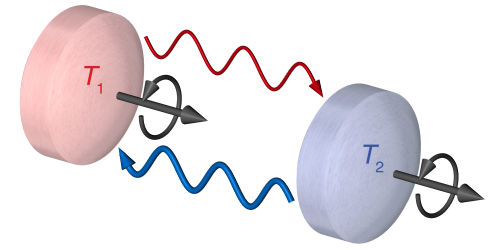Spinning Heat in Reverse
Heat flows from hot to cold, but a fast spin could break that rule. Juan Deop-Ruano and Alejandro Manjavacas from the Institute of Optics (IO-CSIC) in Spain predict that if two nanoscale disks are placed close to each other and rotated at high frequencies, heat could move from the cold disk to the hot one [1]. The duo acknowledge that this behavior will be difficult to reproduce in the lab—at least in the near future—but hope it will still inspire new ideas for controlling the temperature of nanoscale objects.
Many other groups have studied the radiative heat transfer between nanostructures. Likewise, many have probed the so-called Casimir torque acting on nearby nanostructures that rotate with respect to each other. Deop-Ruano and Manjavacas are the first to analyze these two effects simultaneously.
The duo considered two disks—one hot, one cold—whose sizes and separation are much smaller than the dominant wavelength of their thermal radiation. In this situation, the disks are approximated as simple electric dipoles, and their interaction is a combination of thermal radiation and Casimir torque effects. The researchers calculated the energy transfer between the disks and found that a fast-spinning cold disk can give more energy to a hot disk than it receives. “The rotation modifies the energy distribution of the thermal radiation of the disks, making them effectively behave as if they have a different temperature,” Manjavacas says.
For this reversed heat flow to be observable at temperatures around 1 K, the objects need to be rotating at a rate of 100 GHz. Recently, experimentalists have managed to spin nanostructures at a few GHz, so Deop-Ruano and Manjavacas are hopeful that technical advances could allow a test of their predictions in the future.
–Michael Schirber
Michael Schirber is a Corresponding Editor for Physics Magazine based in Lyon, France.
References
- J. R. Deop-Ruano and A. Manjavacas, “Control of the radiative heat transfer in a pair of rotating nanostructures,” Phys. Rev. Lett. 130, 133605 (2023).




